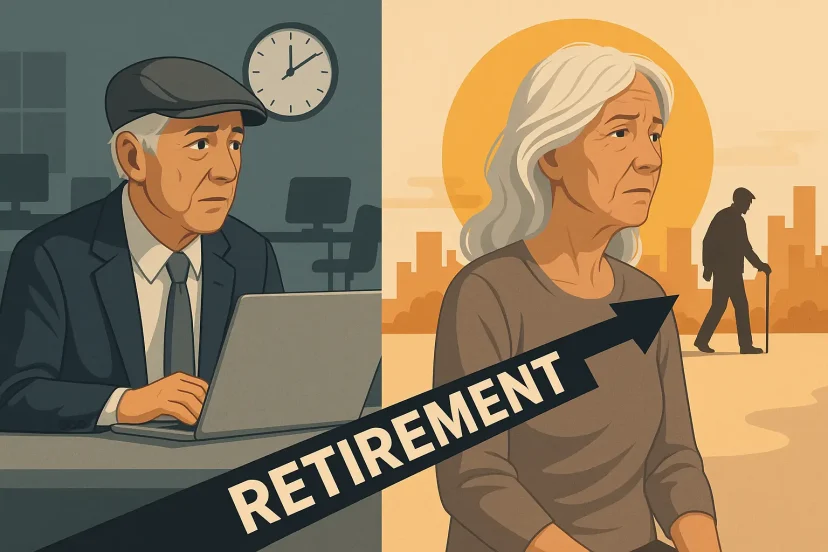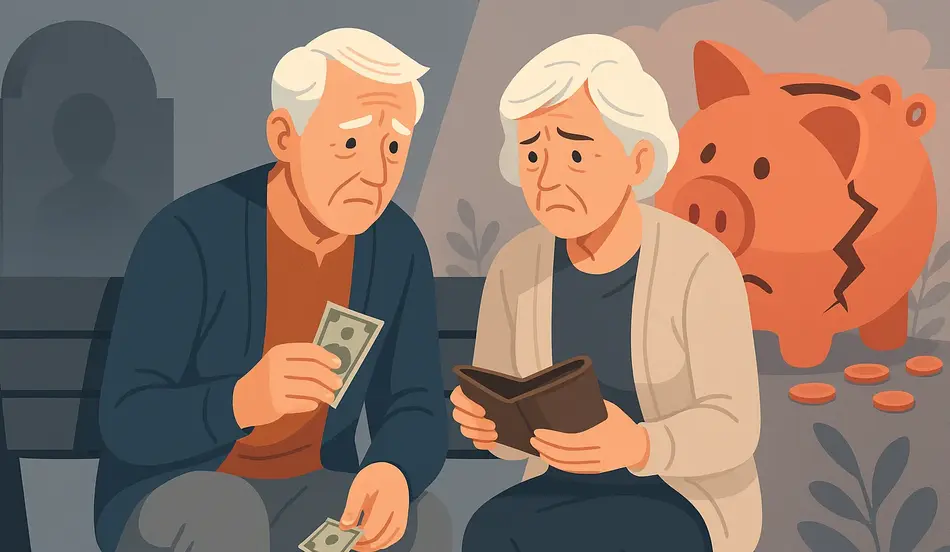The Retirement Crisis 2025 is exposing a harsh truth: for many Americans, the greatest fear in life isn’t death — it’s running out of money in retirement. A recent survey found that 64% of Americans worry more about exhausting their savings than dying, and 1 in 4 believe they may never be able to retire.
As life expectancy rises — now averaging 80 years across OECD countries, up 13 years since 1960 — workers face the prospect of longer retirements and rising financial uncertainty. The three-legged stool of retirement security — Social Security, pensions, and personal savings — is wobbling, leaving millions anxious about their financial futures.
Retirement Crisis 2025 and the Longevity Paradox: Living Longer, Working Longer
On paper, longer life expectancy is a triumph of health and medicine. But it also pushes governments and workers to adjust retirement timelines. More than half of OECD countries have raised retirement ages, and 70% of U.S. workers say they plan to delay retirement.
Yet planning to work longer and actually being able to are very different things. Over half of retirees leave the workforce earlier than planned, often due to layoffs, health challenges, or age discrimination.
The idea that Americans can simply extend their careers indefinitely is a myth, experts caution. “You can’t always work longer because the labor market doesn’t always want you when you want it,” one economist said.

Social Security on the Brink
At the heart of retirement anxiety is the fragile state of Social Security.
- Social Security operates on a pay-as-you-go model: today’s workers fund today’s retirees.
- In the 1960s, 5–6 workers supported each retiree. Today, the ratio is about 3-to-1, and by the 2030s it will fall to 2-to-1.
- The program faces insolvency within seven years unless Congress acts.
While retirees rely heavily on Social Security — 58% call it a major income source — only 35% of non-retirees expect it to sustain them. That expectation gap has persisted for decades.
Many fear looming benefit cuts. Yet most experts believe Congress will intervene to avoid a 20% across-the-board reduction. Still, political inaction has left Americans uneasy.
The Collapse of Pensions and Rise of 401(k)s
A generation ago, many workers could count on employer-funded pensions for retirement security. In 1989, 63% of full-time workers at large firms had pensions. Today, that number is just 15%.
The shift to 401(k)-style defined contribution plans transformed retirement into an individual responsibility. For employers, 401(k)s were cheaper and easier to administer. For workers, they created greater risk and less certainty.
Unlike pensions, which penalized delayed retirement, 401(k)s reward longer careers: the more you contribute, the more you save. But without steady contributions — and with the volatility of markets — millions fall short of the nest egg they need.
Generational Divide: Boomers vs. Millennials vs. Gen Z
Generations are experiencing retirement very differently:
- Baby Boomers: Many benefited from pensions, rising home equity, and decades of growth in equities. But wealth is uneven — the poorest boomers are worse off than their predecessors, and racial and class divides remain wide.
- Gen X and Millennials: More reliant on 401(k)s, but also more burdened by student debt. About 36% of millennials carry student loans, compared to just 7% of boomers.
- Gen Z: Surprisingly, they are saving earlier. Many have more in retirement accounts by age 30 than previous generations did, thanks to greater awareness and automatic 401(k) enrollment. But they are also the most pessimistic, doubting Social Security’s solvency and home equity growth.
One financial expert noted:
“Gen Z is nervous — but if that nervousness makes them save, that’s not a bad thing.”
Policy Battles and New Proposals
The political debate over retirement is heating up.
- Trump’s 2025 executive order opened the door for cryptocurrencies and private equity in 401(k) plans. Critics argue this is a distraction, not a solution.
- Advocates like Teresa Ghilarducci propose a “Gray New Deal”: a universal pension system, stronger Social Security, and government-backed jobs for older workers.
- The National Education Policy (NEP) and workforce development programs emphasize retraining older workers to keep them employable longer.
Ultimately, reforming Social Security to ensure solvency remains the central challenge — one Congress has repeatedly delayed.
Secure Your Career as Retirement Fears Mount
Search WhatJobs for steady, growth-oriented roles that help you build financial resilience and lower your worry of running out of money.
Search Jobs Now →The Workforce Reality: Older Workers in a Shifting Market
Even as policymakers push “work longer” as a solution, real-world barriers remain:
- Age discrimination forces many out of jobs prematurely.
- Skills gaps leave older workers behind as industries automate and digitize.
- Health issues shorten working lives for millions.
Still, older workers can be valuable assets. Research suggests they complement younger colleagues by providing mentorship and experience, while younger workers contribute innovation and adaptability. Together, these dynamics can strengthen workplaces rather than crowding one group out.
FAQs: The Future of Retirement in America
Q1: Why are Americans so worried about retirement?
Longer life spans, the decline of pensions, and Social Security’s looming insolvency leave workers uncertain about their ability to fund decades of retirement.
Q2: Is Gen Z really better at saving for retirement?
Yes — data shows Gen Z is saving earlier and at higher rates than previous generations. But they remain more pessimistic about Social Security and home equity.
Q3: Will Social Security really run out?
Not entirely. Even if the trust fund is depleted, payroll taxes will still fund partial benefits. However, without reform, cuts of around 20% could occur within a decade.
Q4: What reforms could fix the system?
Options include raising payroll taxes, adjusting benefits, expanding universal pensions, or implementing proposals like the “Gray New Deal.” Politically, however, action has been slow.
Bottom Line:
Americans face a retirement system in flux. While Gen Z is saving earlier, pensions are gone, Social Security is strained, and economic inequality is widening. Without bold reform, fears of outliving savings may continue to overshadow the promise of longer, healthier lives.




